
Myrtaceae, the myrtle family, is a family of dicotyledonous plants placed within the order Myrtales. Myrtle, pōhutukawa, bay rum tree, clove, guava, acca (feijoa), allspice, and eucalyptus are some notable members of this group. All species are woody, contain essential oils, and have flower parts in multiples of four or five. The leaves are evergreen, alternate to mostly opposite, simple, and usually entire. The flowers have a base number of five petals, though in several genera, the petals are minute or absent. The stamens are usually very conspicuous, brightly coloured, and numerous.

Backhousia is a genus of thirteen currently known species of flowering plants in the family Myrtaceae. All the currently known species are endemic to Australia in the rainforests and seasonally dry forests of Queensland, New South Wales and Western Australia.

Chamelaucium, also known as waxflower, is a genus of shrubs endemic to south western Western Australia. They belong to the myrtle family Myrtaceae and have flowers similar to those of the tea-trees (Leptospermum). The most well-known species is the Geraldton wax, Chamelaucium uncinatum, which is cultivated widely for its large attractive flowers.
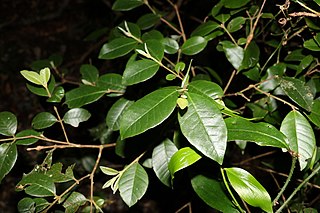
Lenwebbia is a genus of shrubs or small trees in the myrtle family Myrtaceae. The type species is Lenwebbia lasioclada.

Hypocalymma angustifolium, commonly known as white myrtle, or pink-flowered myrtle, is a species of flowering in the myrtle family Myrtaceae, and is endemic to the south west region of Western Australia. The Noongar peoples know the plant as koodgeed or kudjidi. It is an erect, multi-stemmed shrub with narrowly linear leaves, white or pale pink flowers.

Hypocalymma robustum, commonly known as Swan River myrtle, is a species of flowering plant in the myrtle family Myrtaceae, and is endemic to the south-west of Western Australia. It is an erect, multistemmed shrub or shrublet with linear to narrowly oblong leaves and pink flowers arranged in pairs in leaf axils, with 35 to 60 stamens.

Rhodomyrtus is a group of shrubs and trees in the family Myrtaceae, described as a genus in 1841 and native to southern China, the Indian subcontinent, Southeast Asia, Melanesia, and Australia.

Gossia bidwillii, known as the python tree is a rainforest myrtle of eastern Australia. The usual habitat is the drier rainforest areas. The range of natural distribution is from the Hunter River in New South Wales to Coen in far northern Queensland.
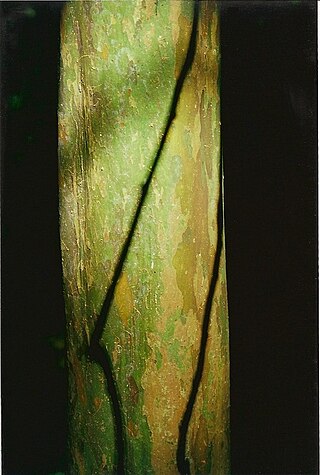
Gossia is a genus of rainforest trees in the myrtle family first described as a genus in 2003 by Neil Snow, Gordon Guymer and Sawvel. It is native to northeastern Australia as well as several islands of Papuasia and New Caledonia.
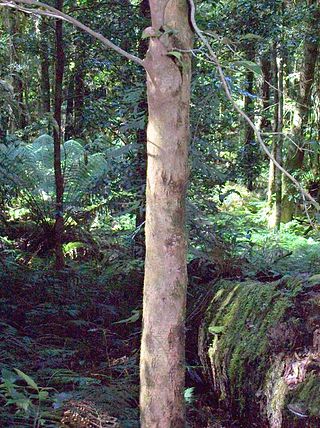
Gossia acmenoides, known as the scrub ironwood, is a rainforest tree of the family Myrtaceae, native to eastern Australia. The usual habitat of this small tree is drier rainforest areas. The range of natural distribution is from Jamberoo in New South Wales to Eungella National Park in northern Queensland.

Uromyrtus lamingtonensis is a rare Australian shrub growing around the state border of New South Wales and Queensland. Like the Peach Myrtle, it has attractive pink flowers.
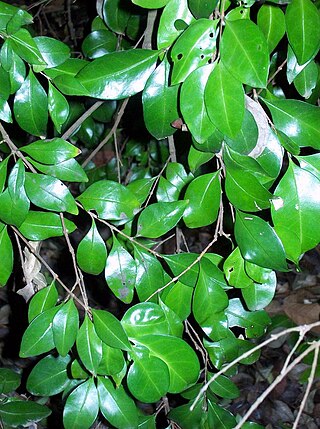
Gossia fragrantissima, the sweet myrtle or small-leaved myrtle, is a shrub or small tree of eastern Australia. A plant with a ROTAP rating of 3EC-, endangered by extinction.

Lithomyrtus is a genus of small trees and shrubs in the myrtle family, Myrtaceae. There are 11 species, native to the tropics of northern Australia and New Guinea:

Lithomyrtus obtusa, commonly known as beach myrtella, is a flowering plant species in the myrtle family, Myrtaceae. It occurs in coastal areas in New Guinea and Queensland, Australia.
Myrtella is a genus of plants in the Myrtaceae described as a genus in 1877. It is native to New Guinea and to some islands of the western Pacific.
- Myrtella beccariiF.Muell. - New Guinea, Solomon Islands
- Myrtella bennigseniana(Volkens) Diels - New Guinea, Caroline Islands, Mariana Islands

Gossia floribunda or Cape ironwood species of plant in the Myrtaceae family. It is a understorey plant growing to a height of 1 to 6 m. Found in Cape York Peninsula Australia and also in New Guinea. Small white flowers form in abundance.
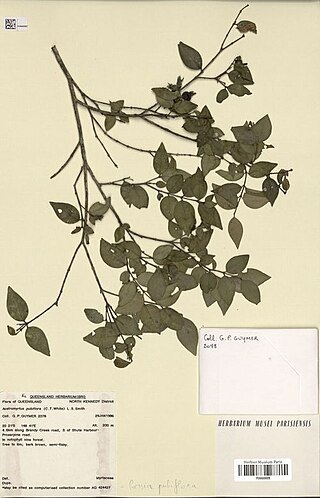
Gossia pubiflora is a species of plant in the family Myrtaceae that is endemic to coastal central east Queensland. It is a shrub or small tree that grows to a height of 1 to 6 m tall.

Gossia gonoclada, known as the square-stemmed or angle-stemmed myrtle for the distinctive four raised corners on the angled branchlets, is a rainforest tree of the family Myrtaceae, native to south-east Queensland, Australia. It is an endangered species.
Gossia byrnesii is a tree in the Myrtaceae family, first described in 2003 by Neil Snow, Gordon Guymer and Sawvel.

Rhodomyrtus pervagata, commonly known as ironwood or rusty rhodomyrtus, is a species of plants in the clove and eucalyptus family Myrtaceae, found only in northeastern Queensland, Australia. It is a shrub or small tree to 8 m (26 ft) high and a trunk diameter up to 14 cm (5.5 in), with simple 3-veined leaves and very small flowers up to 3.5 mm (0.14 in) diameter. It grows in and on the margins of coastal and sub-coastal rainforest, from the Windsor Tablelands south to the Paluma Range National Park. It prefers soils derived from granite or basalt. The species epithet pervagata means 'common' and refers to its habit of growing along roadsides.


















